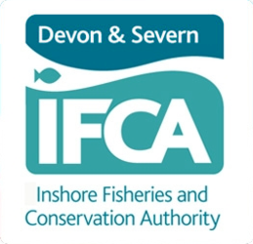Mussels
Page review/updated 04/12/2024
(Content of page last updated: 30th September 2021)
MUSSELS IN D&S IFCA’S DISTRICT
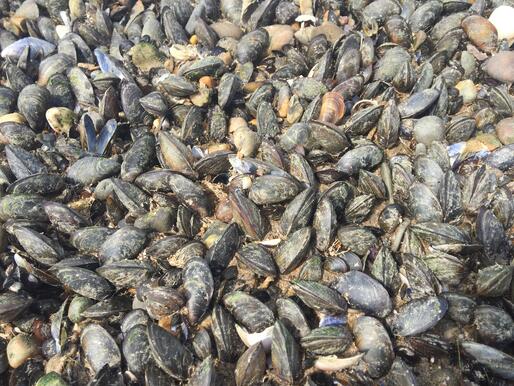
Blue mussels, Mytilus edulis, are historically abundant within D&S IFCA’s District. Reef building, filter-feeding bivalves, found both Intertidally and in the shallow sublittoral they act as important ecosystem engineers within many of the District’s estuaries. They feed mostly on particulate organic matter (POM) and aggregate in habitats where the oceanographic and environmental conditions facilitate high loads of POM, i.e. the turbid channels within estuarine systems. Key to their ability to form large reef structures is their ability to excrete byssus, sticky treads that bind individual mussels to their environment, including the shells of both living and dead mussel. These reefs not only provide substrate for new mussel settlement, but also create a spatially complex habitat utilised by a plethora of species, supporting numerous food webs.
Wading birds are just one of the groups highly dependent on mussel beds. This is an important factor when considering the management necessary for certain estuaries. There are various legislative mechanisms applied at International, European, and National levels which protect wading birds and promote population recovery. One mechanism to aid this is by ensuring that there is adequate provision of the food source for these birds. For example, the oystercatcher Haematopus ostralegus is a designated feature of some of the District’s MPAs and having an abundance supply of mussels is essential for the maintenance of overwintering populations.
D&S IFCA’s officers monitor mussel populations within several of the District’s estuaries on an annual basis. Based on the total estimated biomass of mussels within an estuary, D&S IFCA may apply management measures necessary to protect a portion of the stock necessary for the wading bird populations. These decisions may come in the form of restrictions on the amount of mussel removed, or alternatively in the form of blanket bans on all hand collection should the stock be severely depleted.
MUSSEL STOCK SURVEY METHODOLOGY
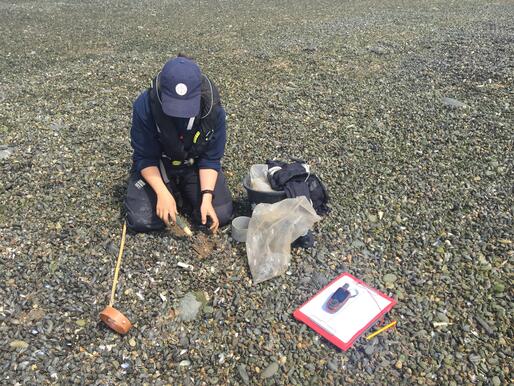
In order to understand how much mussel is present in an estuary and whether the beds are stable or in decline it is necessary to survey the beds in-situ.
Due to the intertidal nature of mussel beds, surveys are subject to tidal constraints. Therefore, surveys are always carried out on the lowest astronomical tide of the month when the greatest proportion of the beds will be exposed. Efficiency during what is normally only a four-hour sampling window is key.
D&S IFCA uses the ‘Dutch Wand’ survey technique, developed by Dutch researchers who survey mussels in the Wadden Sea. The technique is accurate having comparable results on density and biomass of mussel beds to more conventional quadrat surveys, but importantly it is also faster without the loss of resolution. The technique involves swinging a stick or ’wand’, with a measured circular core attached, every three paces across multiple transects. For every swing it is recorded whether the transect was a ‘hit’ if live mussel was present in the core, or ‘miss’ if no live mussel was present. For every fifth hit per transect a sample is taken from inside the core of all the present mussel, this is later measured and weighed by size class. Prior to the survey the perimeters of the bed will be mapped using GPS, the transects will then cross this bed in a zig zag fashion, with a new transect starting every time a transect reaches the limits of the bed.
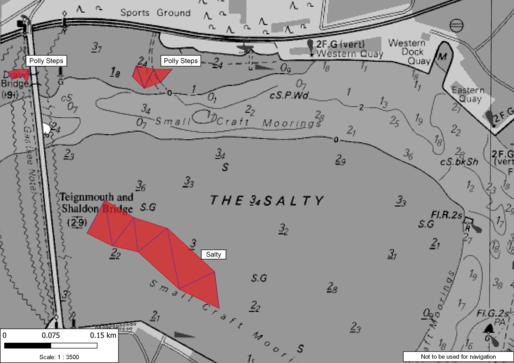
Using the hit and miss data, sample data and GPS data it is possible to calculate approximately how much mussel is present within a certain bed, whether this mussel is old or freshly settled and whether there have been any changes in the bed’s density, and location as well as the bed’s spatial coverage year on year.
In addition to D&S IFCA’s calculations and inferences on the stock based on these data, Natural England then uses these data, in conjunction with that year’s wading bird estimates and feeding rates, to calculate exactly how much of this mussel stock is likely to be consumed by wading birds for that year per estuary.
EXE ESTUARY
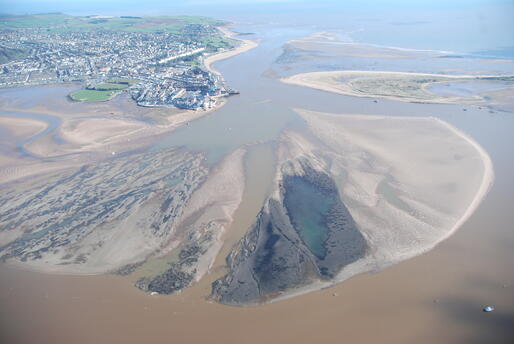
The Exe Estuary is designated as a SPA, SSSI and Ramsar site, with wading birds and over wintering birds forming a significant proportion of the protected species within the estuary. It is currently one of the estuaries subject to a prohibition on the removal of mussels from certain areas of public beds. The prohibition was introduced under D&S IFCA’s Byelaw 9 – temporary Closure of Shellfish Beds’, and started on 1st May 2019. The prohibition was required due to the severe decline of many of the estuary’s beds following large storms in the winter of 2013-14 and subsequent but unrelated harmful algal bloom events. These beds have not since recovered to pre-2014 levels prompting such action as necessary to allow the beds to recover. The beds in their pre-2014 extent covered much of the intertidal parts of the estuary, notably on Bull Hill Bank, Starcross, and at Lympstone with a combine estimate of around 2000 tonnes. This dropped sharply in 2014 to less than 100 tonnes and was estimated at less than one tonne in 2019. More mussel was found during surveys in 2020, but this was a small amount compared to pre-2014 levels and recovery of the beds may take a considerable amount of time, even with the Temporary Shellfish Closure. Pacific oyster reefs have become more established in the estuary in recent years and it may be that in the mussel’s absence they are fulfilling similar ecosystem functions, i.e. reef building, habitat creation and filter feeding.
TEIGN ESTUARY
The Teign Estuary, unlike the Exe Estuary, is not covered by any statutory designations and to date has not been surveyed as frequently by D&S IFCA. Despite this lack of designation there have historically been large mussel beds present in the estuary, particularly below the Shaldon Bridge on the Salty and at Polly Steps. Hand gathering for mussels and cockles has taken place for generations on these beds. D&S IFCA has surveyed these beds to monitor the mussel stocks to ensure they are not over exploited. The data collected help inform management and potential future measures such as the review of hand working being conducted, which commenced in 2019. The 2018 survey found that the mussel stocks on these beds have decline dramatically, similarly to those on the Exe Estuary, from around 1100 tonnes in 2012 to less than one tonne in 2018. Loss of mussels is likely to be as a result of the 2014 storms but the lack of data between 2012-18 means that it is not possible to clearly define the decline over this time period. No recovery of the mussel beds has been detected in subsequent surveys. The public mussel beds within the Teign Estuary were closed to removal of mussels from the 1st May 2019.
Currently, the surveyed areas no longer represent habitats in which large expanses of dense live mussel can be found, and live mussel is negligible except for very small areas where sparse patches of live mussel can be found. No mussel spat (>30mm) has been detected on the estuary during the past three years. D&S IFCA will continue to undertake surveys to monitor for signs of population recovery across all the public beds. Until such signs become apparent it is unlikely that the public shellfish beds will be reopened.
TAW-TORRIDGE ESTUARY
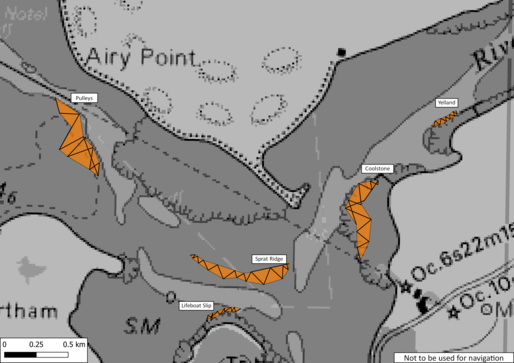
The Taw-Torridge Estuary is a designated SSSI. Similarly to the Exe Estuary, it is an important roosting site for over wintering birds and waders. The mussel beds within the estuary serve as an important food source for many of these birds and are recognised as such. D&S IFCA has been monitoring these beds since 2012. The mussel beds have also suffered significant reductions in both population size and biomass, as well as spatial coverage, following the 2014 storms. With the decline in mussel stock, not only in the Estuary but nationwide, and an increased interest in shellfishermen from across the country wishing to harvest the mussels, Natural England and D&S IFCA worked together to put in place a restriction on the amount of mussels that can be harvested commercially from the beds within the Taw Torridge. A maximum removal of 500kg per month by all combined individuals was set, and each harvester must alert D&S IFCA and Natural England of their intentions to harvest mussels and then subsequently submit a catch report with total quantity taken to both organisations on a monthly basis.
The Taw Torridge Estuary, unlike the Exe or the Teign, is very much still a viable mussel fishery, although harvesting must be carefully regulated so that the over wintering bird have an adequate food source and there are enough remaining mussel stocks to allow for the viability and sustainability of the beds. Although the mussel population has seen significant reductions in biomass from 2012-2019 amounting to approximately 1500 tonnes of loss, many of the beds surveyed are still intact, notably Pulleys and Sprat Ridge. The current estimate tonnage of mussel within the estuary now amounts to approximately 1000 tonnes, 300 tonnes higher than surveyed in 2015. Many of the smaller beds are much patchier in distribution, but the two estuarine beds are homogenous and are what could be described as ‘true’ mussel beds. The beds are classified by Cefas and renewed interest in their commercial exploitation combined with a more stable population may see the continuation of mussel farming within the estuary. D&S IFCA will continue to monitor the population biomass for any changes, to inform Natural England of food availability for wading birds and to ensure sustainable management of the mussel beds.
- The 2019 Taw-Torridge Mussel Stock Assessment Report can be viewed here.
- The 2020 Taw Torridge Mussel Stock Assessment Report can be viewed here.
- The 2021 Taw Torridge Mussel Stock Assessment Report can be viewed here.
Subtidal Mussel
Until 2020, the extent and density of the subtidal mussel resource in the Taw-Torridge system had not previously been assessed, though the subtidal mussel may play an important role in reseeding intertidal areas, providing food and habitat for local wildlife, and performing other important ‘ecosystem services’. Therefore, in October 2020, D&S IFCA worked with two local fishermen to conduct a broad-scale survey of the estuary. This survey used a device known as a Van Veen grab, deployed from a local fishing vessel, to take samples of the estuary bed from the Crow Point/ Coolstone area through the main channel to the estuary mouth. Sample areas were guided by important fisher knowledge of the local environment. The objective of this project was to define the location of subtidal mussel beds, ground-truthing and updating local knowledge of mussel distribution. The contents of all Van Veen grab samples were assessed for mussel presence, abundance and mussel length. Results of this survey have expanded D&S IFCA’s understanding of the subtidal mussel resource, which will help to inform future management of local mussel beds and the development of shellfisheries in this part of the D&S IFCA’s District. Further research is being undertaken in 2021 to increase D&S IFCA’s knowledge of the system and improve the capacity to sustainably manage the shellfishery within ecological limits.
- The 2020 Taw-Torridge Subtidal Mussel Assessment Report can be viewed here.
